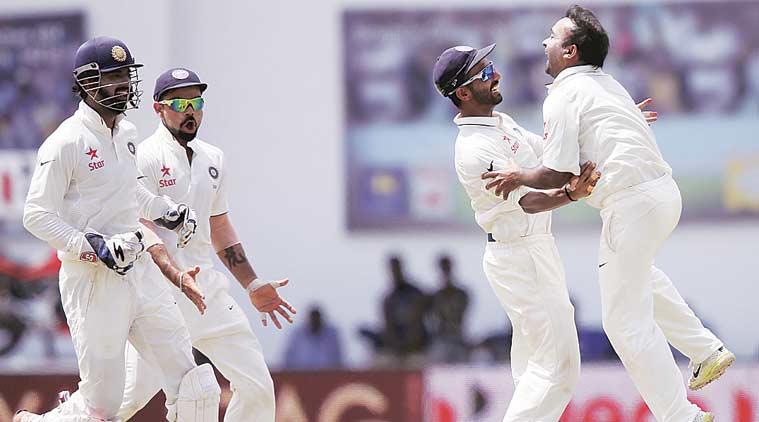Test Cricket’s Non-Negotiables: Openers, keepers should always be specialists
 KL Rahul (far left) donned the wicketkeeping gloves in the final innings of the second Test after Wriddhiman Saha was injured. (Source: PTI)
KL Rahul (far left) donned the wicketkeeping gloves in the final innings of the second Test after Wriddhiman Saha was injured. (Source: PTI)
There are rules, processes, conventions, all being dismantled before our eyes as change, driven by technology and preferences, sweeps through our lives. Cricket’s visible manifestation of this is T20 where people bat anywhere, spinners use the new ball and fast bowlers the slightly older one and even wicket keepers have occasionally been done away with! And just as a generation looked at T20 cricket through eyes that had seen a rather different game answering to that name, and a little sneer became permanent, we could start seeing the influence of T20 in the way Test cricket is viewed. And, indeed, approached.
There is nothing permanent in T20, but Test cricket has its non-negotiables and when I heard talk of stand-in openers and stop-gap wicket keepers I wondered whether a new generation is looking at Test cricket differently. Batsmen have been pushed up in the past and lesser keepers have been picked because they could bat but in an overwhelming majority of cases, the decision has been proved wrong. Teams have been set back as India have discovered over the years when the search for an opener began in their middle order. Virender Sehwag — and to some extent Ravi Shastri also — is a rare example of someone who made a success of the move. (And even Sehwag once said said he might have scored more at number 4!) But you only have to look at Sardesai, Mankad, Solkar, Gaekwad even upto Mongia and beyond to realise it wasn’t going to be.
It is tempting to push people to open the batting in India-like conditions where the new ball isn’t the weapon it is overseas. Even fast bowlers here prefer one that is a bit older and so opening the batting can create an illusion of safety. It is revealing that when Murali Vijay had to leave the tour, India didn’t choose to ask for another opener preferring instead, to consider pushing Pujara up. Luckily India has three openers to choose from currently, but opening the batting is a specialist position, and India will have to stay away from the temptation of pushing an often unwilling middle-order man up.
A dangerous thought
Far more dangerous is the thought of using a stop-gap wicket keeper, and I only hope that this is an attempt at filling newspaper space and air-time. It is one thing to stick the gloves on anyone and put them behind the stumps in a 120-ball game, where the ball rarely beats the bat, but quite another to expect someone to go up and down behind the stumps against quality spin on a turning track. Standing back is the easier part of keeping and performance there is rarely an indicator of how good you can be standing up. Already we have seen, in the Ashes and in Sri Lanka, how a dropped catch can change the fortunes of a game, occasionally a series. The impact of a drop isn’t something you can easily assign a number to and so it tends to be forgotten rather quickly; which is also why a lot of keepers have been judged on their batting average which is easier to quantify.
Old heads will always tell you that you must pick your best wicket-keeper first and only consider a batting average if there is little to choose between two contenders. And nothing in the game has caused that to be challenged. You pick your best openers without worrying if one of them can bowl decent off-breaks. So too with keepers and that is why it is imperative that talk of a stand-in keeper in a Test match, like most chatter in the news, be allowed to be forgotten almost immediately. It isn’t fair on the stand-in man and it is definitely not fair on the bowlers for whom the keeper is a staunch ally.
For a little while anyone can play anywhere but even the libero in football never played as a goalkeeper. There are non-negotiables, and in Test cricket, your openers and your wicket keeper will always be specialist players. I hope India is wary of too much change there.





